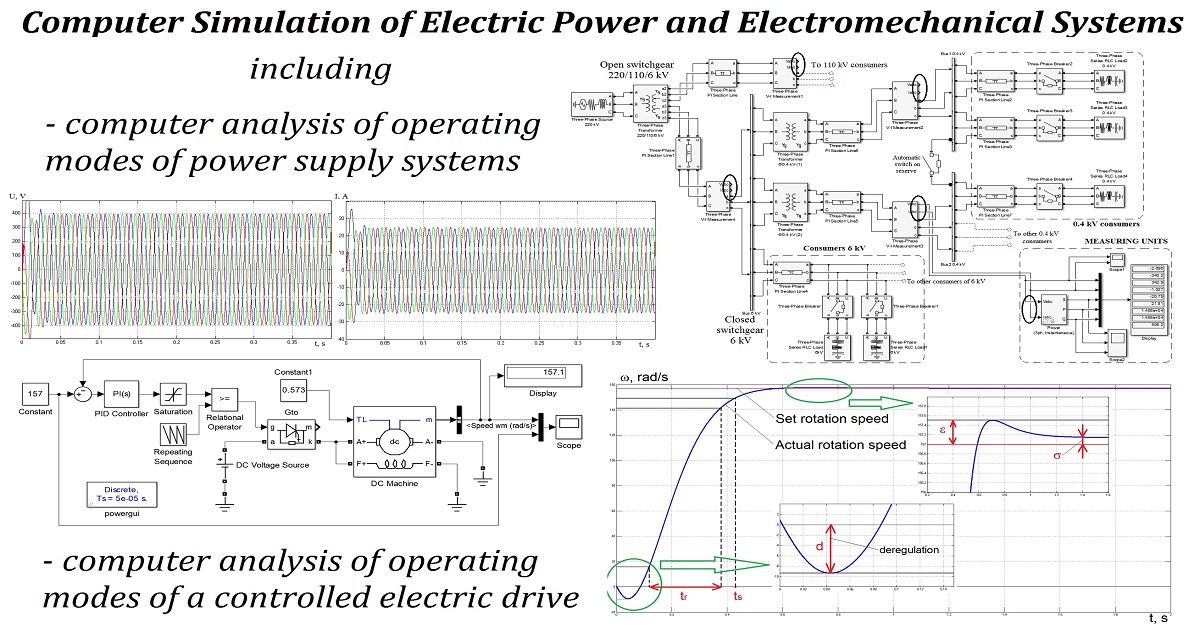Computer Simulation of Electric Power and Electromechanical Systems
A special issue of Applied Sciences (ISSN 2076-3417). This special issue belongs to the section "Electrical, Electronics and Communications Engineering".
Deadline for manuscript submissions: closed (31 May 2023) | Viewed by 5564

Special Issue Editor
Interests: variable frequency drive; power converters; mathematical modeling; applied physics; electrical engineering and electronics; energy efficiency and conservation
Special Issues, Collections and Topics in MDPI journals
Special Issue Information
Dear Colleagues,
Cutting-edge computer science and information technology make the computer modeling of electrical power and electromechanical systems a convenient tool for studying the physical processes of such systems. The testing and analysis of electricity delivery systems and electric drives are becoming ever more complicated using conventional computing.
Computer modeling is a process of rendering the behavior of a system while varying its parameters. In practice, modeling refers to an adequate representation of a system under consideration by a model to be analyzed by known methods.
In the energy sector, computer simulation has found broad use in VFD applications, the development of controllers, and the analysis of the energy efficiency of high-power units running at industrial facilities.
Additionally, many research and educational institutions use various computer simulation software to research and learn about electric power systems.
This Special Issue is intended to:
- Improve the knowledge of computer modeling software;
- Further the knowledge of novel modeling methods in the electric power industry;
- Prove the concept of computer simulation for evaluating the energy efficiency of units;
- Share experience in the application of computer modeling in industry, science, and education.
This Special Issue covers topics including but not limited to the following:
- Electric drive system modeling;
- Electricity delivery system modeling;
- Controller modeling;
- Modeling electric power systems based on renewable energy;
- Modeling electric power systems of industrial facilities;
- Optimal choice of methods for electric power system modeling;
- Computer modeling of electric power systems in science and education.
Dr. Alexander S. Semenov
Guest Editor
Manuscript Submission Information
Manuscripts should be submitted online at www.mdpi.com by registering and logging in to this website. Once you are registered, click here to go to the submission form. Manuscripts can be submitted until the deadline. All submissions that pass pre-check are peer-reviewed. Accepted papers will be published continuously in the journal (as soon as accepted) and will be listed together on the special issue website. Research articles, review articles as well as short communications are invited. For planned papers, a title and short abstract (about 100 words) can be sent to the Editorial Office for announcement on this website.
Submitted manuscripts should not have been published previously, nor be under consideration for publication elsewhere (except conference proceedings papers). All manuscripts are thoroughly refereed through a single-blind peer-review process. A guide for authors and other relevant information for submission of manuscripts is available on the Instructions for Authors page. Applied Sciences is an international peer-reviewed open access semimonthly journal published by MDPI.
Please visit the Instructions for Authors page before submitting a manuscript. The Article Processing Charge (APC) for publication in this open access journal is 2400 CHF (Swiss Francs). Submitted papers should be well formatted and use good English. Authors may use MDPI's English editing service prior to publication or during author revisions.
Keywords
- computer modeling
- electric power system
- electric drive
- electricity delivery
- energy efficiency
- automation
- optimization
- industry
- renewable energy
Benefits of Publishing in a Special Issue
- Ease of navigation: Grouping papers by topic helps scholars navigate broad scope journals more efficiently.
- Greater discoverability: Special Issues support the reach and impact of scientific research. Articles in Special Issues are more discoverable and cited more frequently.
- Expansion of research network: Special Issues facilitate connections among authors, fostering scientific collaborations.
- External promotion: Articles in Special Issues are often promoted through the journal's social media, increasing their visibility.
- e-Book format: Special Issues with more than 10 articles can be published as dedicated e-books, ensuring wide and rapid dissemination.
Further information on MDPI's Special Issue polices can be found here.





